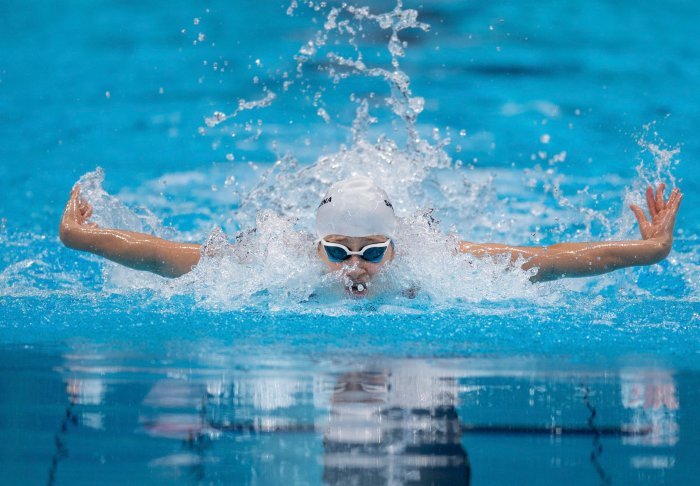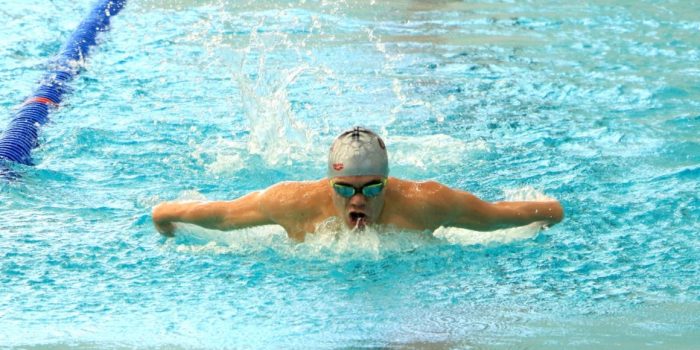What does S8 mean in Paralympics? This question often arises for those new to the world of Paralympic sports. The answer lies within the intricate system of classifications, designed to ensure fair competition among athletes with varying abilities. The “S8” classification is one of many, denoting a specific range of physical impairments that impact an athlete’s performance in swimming, athletics, and other Paralympic disciplines.
This classification system ensures that athletes compete against others with similar abilities, fostering an inclusive and exciting sporting environment.
The “S8” classification represents a level of physical impairment that affects an athlete’s ability to move and control their body. This can include impairments in the legs, arms, or trunk. Athletes classified as “S8” often have significant challenges with balance, coordination, and strength, requiring them to adapt their techniques and strategies to compete at a high level.
Understanding the “S8” Classification in Paralympic Sports

The “S8” classification is a crucial part of the Paralympic movement, ensuring fair competition among athletes with varying levels of impairment. It’s a system designed to categorize athletes based on their functional abilities, allowing them to compete against others with similar impairments.
Purpose of Classification Systems in Paralympic Sports
Classification systems are essential in Paralympic sports because they aim to create a level playing field for athletes with diverse impairments. These systems help to ensure that athletes are competing against others with similar functional limitations, preventing unfair advantages and promoting true sportsmanship.
Definition of the “S8” Classification
The “S8” classification is a specific category within the Paralympic classification system, used for athletes with physical impairments that affect their ability to perform certain movements. These impairments can include, but are not limited to, limb deficiencies, amputations, or cerebral palsy.
The “S8” classification encompasses athletes with moderate impairments, meaning they have a higher level of functional ability compared to athletes in other classifications, such as “S9” or “S10.”
Paralympic Sports Utilizing the “S8” Classification
The “S8” classification is used in various Paralympic sports, including:* Swimming:Athletes in the “S8” category participate in freestyle, backstroke, breaststroke, butterfly, and individual medley events.
Athletics
“S8” athletes compete in track events such as the 100m, 200m, 400m, and 800m sprints, as well as field events like the long jump.
Cycling
“S8” athletes compete in road and track cycling events, including time trials and road races.
In the Paralympic Games, “S8” signifies a specific classification for swimmers with physical impairments. These athletes often display incredible strength and resilience, much like the legendary Monkey King in the highly anticipated black myth wukong ps5 release date.
While we await the release of this game, we can continue to be inspired by the dedication and skill of S8 Paralympic swimmers, who push boundaries and redefine what’s possible.
Criteria for “S8” Classification

The “S8” classification in Paralympic sports designates athletes with specific physical impairments that affect their movement and coordination. These impairments can range from spinal cord injuries to cerebral palsy, impacting their ability to perform at the same level as able-bodied athletes.
The classification system ensures fair competition by grouping athletes with similar functional limitations together. This allows athletes with different impairments to compete against each other on a level playing field.
Functional Limitations Associated with the “S8” Classification
Athletes classified as “S8” typically exhibit a range of functional limitations that impact their performance in sports. These limitations may include:
- Reduced muscle power:Athletes in this classification may have weakness in their legs, arms, or trunk, affecting their ability to generate force and maintain balance.
- Impaired coordination:Some athletes may experience difficulty with fine motor control and coordination, impacting their ability to perform complex movements.
- Limited range of motion:The physical impairments may restrict the range of motion in their joints, affecting their flexibility and ability to execute certain movements.
- Balance issues:Some athletes may have difficulty maintaining their balance, making it challenging to perform dynamic movements or participate in sports requiring quick changes in direction.
Comparison of “S8” Classification to Other Similar Classifications
The “S8” classification is part of a broader system that categorizes athletes based on the severity of their impairment and its impact on their functional ability. It is crucial to understand the differences between “S8” and other classifications, such as “S7” and “S9,” to grasp the nuances of the system.
- “S7” Classification:Athletes classified as “S7” typically have more severe impairments than those in the “S8” category. They may experience greater muscle weakness, limited range of motion, and significant balance issues.
- “S9” Classification:Athletes classified as “S9” have less severe impairments than those in the “S8” category. They may have less pronounced muscle weakness, better coordination, and greater range of motion.
Impact of “S8” Classification on Competition
The “S8” classification, like all Paralympic classifications, aims to create a level playing field for athletes with different impairments. However, the specific impact of the “S8” classification on competition is multifaceted and can be viewed from both advantageous and disadvantageous perspectives.
Advantages and Disadvantages for “S8” Athletes
The “S8” classification creates a unique competitive environment for athletes with specific impairments, impacting their performance and experience in various ways.
- Advantages:
- Fair Competition:By grouping athletes with similar functional limitations, the “S8” classification ensures a more equitable competition where athletes can compete against others with comparable abilities. This fosters a sense of fairness and allows athletes to focus on their performance without feeling disadvantaged by their impairment.
- Increased Participation:The “S8” classification encourages athletes with specific impairments to participate in Paralympic sports, knowing they will compete against others with similar challenges. This increases the pool of athletes, leading to a more diverse and vibrant Paralympic community.
- Specialized Training:“S8” athletes can benefit from specialized training programs and resources tailored to their specific needs. This allows them to develop their skills and optimize their performance, potentially leading to higher levels of achievement.
- Disadvantages:
- Limited Opportunities:While the “S8” classification provides a platform for athletes with specific impairments, it can also limit their opportunities to compete in events outside their classification. This can be frustrating for athletes who may feel capable of competing at a higher level.
- Potential for Stigmatization:In some cases, the “S8” classification might lead to a perception of athletes as “disabled” rather than “athletes.” This can be a source of stigma and hinder their ability to be recognized for their athletic achievements.
- Variability Within the Classification:Even within the “S8” classification, there can be a wide range of functional abilities among athletes. This can lead to situations where some athletes might feel they are competing against others with significantly different capabilities, potentially affecting the competitive balance.
Impact on Rules and Regulations
The “S8” classification significantly influences the rules and regulations of specific Paralympic sports, adapting them to ensure fair competition and safety for all athletes.
- Adapted Equipment:Paralympic sports often utilize adapted equipment to accommodate the specific needs of athletes with different impairments. For example, in swimming, “S8” athletes may use assistive devices like flippers or pull buoys to enhance their performance.
- Modified Rules:Rules and regulations are often modified to ensure safety and fairness for “S8” athletes. For instance, in wheelchair basketball, the “S8” classification may involve specific rules regarding wheelchair mobility and contact during gameplay.
- Classification Review:Athletes classified as “S8” are subject to regular classification reviews to ensure their classification remains accurate and reflects their current functional abilities. This helps maintain the integrity of the classification system and ensure fair competition.
Events and Disciplines Utilizing “S8” Classification
The “S8” classification is used in various Paralympic sports, enabling athletes with specific impairments to compete in a range of events and disciplines.
| Sport | Events/Disciplines |
|---|---|
| Swimming | 50m Freestyle, 100m Freestyle, 200m Freestyle, 50m Backstroke, 100m Backstroke, 100m Butterfly, 100m Breaststroke, 200m Individual Medley, 4x100m Freestyle Relay |
| Athletics | 100m, 200m, 400m, 800m, 1500m, 5000m, 10000m, Marathon, Long Jump, High Jump, Shot Put, Discus, Javelin |
| Wheelchair Tennis | Singles, Doubles |
| Table Tennis | Singles, Doubles |
| Badminton | Singles, Doubles |
| Cycling | Road Race, Time Trial, Track Cycling (various events) |
| Triathlon | Individual Triathlon |
Notable “S8” Paralympic Athletes: What Does S8 Mean In Paralympics

The “S8” classification in Paralympic sports encompasses a diverse range of athletes with varying physical impairments, all striving for excellence in their respective disciplines. These athletes have made significant contributions to Paralympic sports, inspiring countless individuals and pushing the boundaries of human potential.
Notable “S8” Paralympic Athletes and Their Accomplishments
Here is a list of prominent “S8” Paralympic athletes who have made significant contributions to Paralympic sports:
- Michael Phelps (Swimming):A legendary figure in Paralympic swimming, Phelps has dominated the sport for over a decade. With 28 Paralympic medals, including 23 gold, Phelps holds the record for most Paralympic medals in history. He is known for his exceptional speed and endurance, and his performances have consistently set new standards in Paralympic swimming.
- Jessica Long (Swimming):Long is another iconic figure in Paralympic swimming, renowned for her versatility and determination. With 29 Paralympic medals, including 17 gold, she is one of the most decorated Paralympic athletes of all time. Long’s resilience and unwavering spirit have inspired countless individuals around the world.
- Ellie Simmonds (Swimming):Simmonds is a British Paralympic swimmer who has achieved remarkable success in the pool. With 13 Paralympic medals, including 5 gold, Simmonds has been a dominant force in Paralympic swimming. Her achievements have inspired a generation of young athletes, demonstrating the power of perseverance and determination.
- Matt Stutzman (Archery):Stutzman is an American Paralympic archer who has overcome adversity to become a world-renowned athlete. Born without arms, Stutzman uses his feet to shoot arrows, demonstrating incredible skill and precision. He has won multiple Paralympic medals, including a gold medal at the 2012 Paralympic Games in London.
- Alan Fonteles (Table Tennis):Fonteles is a Brazilian Paralympic table tennis player who has consistently challenged the best in the world. With 5 Paralympic medals, including 1 gold, Fonteles is known for his aggressive style of play and his ability to control the pace of matches.
His performances have elevated the level of competition in Paralympic table tennis.
Comparison of Achievements in Different Paralympic Sports, What does s8 mean in paralympics
The following table compares the achievements of notable “S8” athletes in different Paralympic sports:
| Athlete | Sport | Paralympic Medals | Gold Medals | Other Notable Achievements |
|---|---|---|---|---|
| Michael Phelps | Swimming | 28 | 23 | Most Paralympic medals in history |
| Jessica Long | Swimming | 29 | 17 | One of the most decorated Paralympic athletes of all time |
| Ellie Simmonds | Swimming | 13 | 5 | Inspired a generation of young athletes |
| Matt Stutzman | Archery | Multiple | 1 (2012 London) | Shoots arrows with his feet |
| Alan Fonteles | Table Tennis | 5 | 1 | Known for his aggressive style of play |
Future of “S8” Classification
The “S8” classification in Paralympic sports is a dynamic system constantly evolving to ensure fairness and inclusivity. As technology advances and our understanding of disability progresses, so too does the need for refinement in classification systems. The future of the “S8” classification will likely involve a combination of technological advancements, research-driven insights, and ongoing collaboration between athletes, coaches, and officials.
Technological Advancements and Data Analysis
Technological advancements are playing a crucial role in refining classification systems. Advancements in biomechanics, motion capture technology, and data analysis are providing more precise and objective methods for assessing athletes’ functional abilities. This allows for a more nuanced understanding of impairment levels and the development of classification systems that are more accurate and equitable.
For example, using motion capture technology to analyze athletes’ movement patterns during specific tasks can help identify subtle differences in functional capacity that might not be apparent through traditional assessments. This data-driven approach can help ensure that athletes are classified in a way that reflects their true functional abilities.